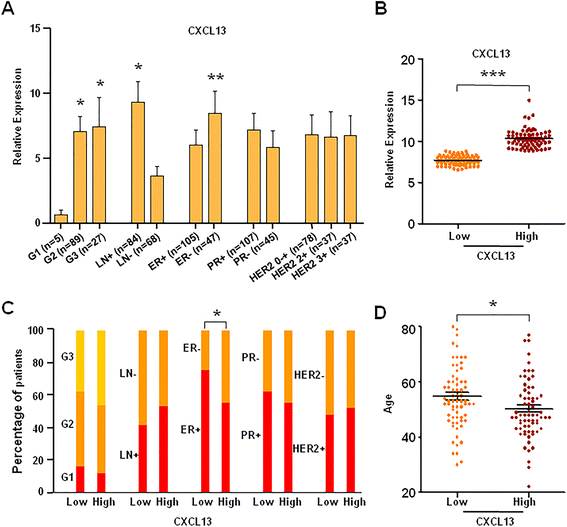The expression of CXCL13 and its relation to unfavorable clinical characteristics in young breast cancer
- PMID: 25990390
- PMCID: PMC4471911
- DOI: 10.1186/s12967-015-0521-1
The expression of CXCL13 and its relation to unfavorable clinical characteristics in young breast cancer
Erratum in
-
Erratum to: The expression of CXCL13 and its relation to unfavorable clinical characteristics in young breast cancer.J Transl Med. 2016 Nov 15;14(1):318. doi: 10.1186/s12967-016-1069-4. J Transl Med. 2016. PMID: 27846893 Free PMC article. No abstract available.
Abstract
Background: Young breast cancer occupies a higher and higher proportion of breast cancer, especially in Asia, and is associated with a more unfavorable prognosis compared with the disease arising in older women. However, the poor prognosis of young breast cancer cannot be fully explained by the clinical and molecular factors.
Methods: This study investigated 1125 Chinese breast cancer patients diagnosed from 2009 to 2013. A data mining of gene expression profiles was performed for the young and older breast cancer patients, identifying significantly differentially expressed genes. Quantitative RT-PCR, Western blotting and immunohistochemistry assay were carried out for the clinical sample validations.
Results: The investigation firstly displayed that young patients (≤45 years) accounted for 47.6 % (535/1125) of breast cancer, and clinically associated with some unfavorable factors related to poor prognosis, such as invasive pathological type, high tumor grade, lymph node positive, ER negative and triple-negative subtype. Subsequently, 553 significantly differentially expressed genes were identified by the data mining. Of them, a set of genes related to immune function were observed to be up-regulated in young patients with breast cancer. Impressively, the CXCL13 (C-X-C motif chemokine 13) expression level showed the most significant difference (FC = 2.64, P = 8.2 × 10(-4)). Furthermore, the validations with clinical samples and correlation analysis demonstrated that CXCL13 was indeed highly expressed in young breast cancer and closely associated with some prognostic factors including lymph node positive and ER negative.
Conclusion: This is the first to indicate the clinical relevance of CXCL13 to young breast cancer and represents a potential therapeutic target for young breast cancer.
Figures





References
-
- Bandi P, Boone M, Brinton L, Buchert S. Breast cancer facts & figures 2009–2010. Atlanta: American Cancer Society; 2010.
Publication types
MeSH terms
Substances
LinkOut - more resources
Full Text Sources
Other Literature Sources
Medical

